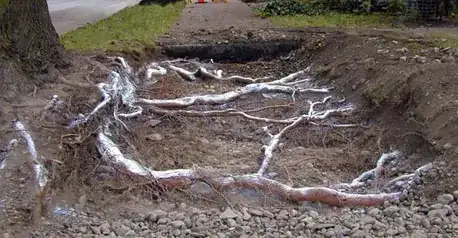I had somebody remove some oak tree roots from the ground one month ago. Now a couple of branches look dried. Others have no new leaves growing and the old leaves are dropping. This is in Houston, Texas. What should I do to save this tree? Thanks!
-
1Welcome to the site Jenny! Would you kindly add a picture or two to your question? It would really help if we could see the whole tree, and the dried branches. You can get back into your question by pressing the gray "edit" button the bottom, or simply press this [edit]. If you have any trouble posting pictures, leave a note and someone will show you how. We're glad you're here, and are happy to try and help you save this tree! – Sue Saddest Farewell TGO GL Feb 27 '16 at 18:24
-
What percentage of the roots were removed? – Graham Chiu Feb 27 '16 at 20:43
-
Your arborist should advise you whether the tree should be removed or an attempt made to save it. Tree will be weakened making it susceptible to borer and other insect damage – Graham Chiu Feb 27 '16 at 21:37
-
What type of oak is it? Some are very sensitive and some are more tolerant. – gorav Mar 04 '16 at 01:00
3 Answers
I had a large (massive) Elm tree that had all the roots on one side cut about 6 feet from the tree due to an idiot plumber running a sewer pipe. This was a deep trench, too.
I used an in-ground water injector to pump root stimulator into the soil all around the tree base. I went around with a hose and penetrated the ground around the tree about 20 feet apart in concentric rings about 10 feet apart around the whole tree. I would inject just the water for about 30 minutes then pour the root stimulator into the hose and then turn the water back on for 30 minutes. I did this over a 1 week period working around the tree. Don't do too much too fast or you will saturate the ground and the tree could fall over.
Despite this happening during summer in Atlanta, 10 years later the tree is still huge—roots are growing like crazy. A water injector is a pipe you can get at garden store. It's a pipe about 3 feet long, and you screw the hose in the top. There is a valve that lets air in the line as the water runs to help oxygenate the soil. I would push this in and then as the hard soil loosened I would push it all the way in.
I hope you are able to save it.
-
Elm's have been pretty rare across North America for more than twenty years due to Dutch Elm disease. Are you sure it's an Elm? – kevinskio Feb 28 '16 at 02:22
-
-
@kevinsky - Until recently I lived in Alexandria, VA, and I had a massive American elm tree in my yard that was entirely unaffected by Dutch Elm Disease. Such hardy trees do exist. :-) – Mico Feb 28 '16 at 09:24
-
@Kevinsky - yes it is an Elm - quite rare - quite beautiful. Hence the extensive effort to save it. Amazingly, seeds have taken root in some old plant pots full of soil near it in the yard and also in our vegetable garden so now we have a small crop of new elms growing for 3 years now - will move them into other parts of the yard once they get stronger. – TreeMan Feb 29 '16 at 03:14
-
Seeds taking root are not so very amazing. 3-6 inch elm are quite common around here. Living past that size with DED around is a different matter – Ecnerwal Feb 29 '16 at 16:10
It may not be possible to save the tree - if you're lucky, some parts will survive, and when you see where the dead areas are, you could have those removed. Cutting out roots like that means you've effectively interfered with the tree's means of survival - you can remove branches at the right time without ill effect, but removing roots, particularly if they are large, is much more serious. There is nothing you can do - only time will tell.
- 131,823
- 3
- 72
- 162
-
There's always the "time machine back to before you cut the roots" method. Lacking that, This. – Ecnerwal Feb 27 '16 at 18:30
-
Could the tree be helped by more extensive fertilizing/watering of the roots which do remain? That is, can you attempt to supplement what the tree is missing from the now-absent roots? – R.M. Feb 27 '16 at 18:54
-
fertilizer won't change the fact that a substantial number of leaves no longer receive nutrients from their roots. Time and water will help. – kevinskio Feb 27 '16 at 20:31
Oak trees along with cotton wood are good at enduring dug up roots as long as they are not punctured heavily (deep cuts). As long as the roots are covered by soil and there's a constant supply of water then the tree should heal its wounds. Other than that there's not much you can do to save the tree.
